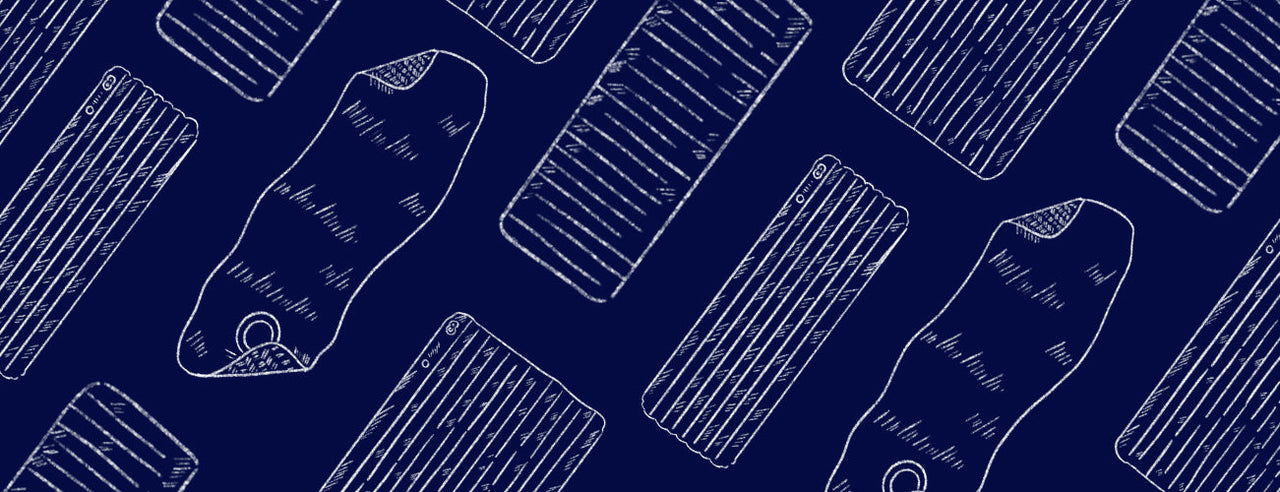Stay Off the Ground.
Sleeping pad leaks in the backcountry can deflate any trip. Master these DIY pad repairs, and you'll be ready for the worst.
How To Locate a Leak
Inflate the pad and use a spray bottle with mild soap to cover the surface of the pad. Once a section of the pad is covered in soapy water, apply pressure to the pad and look for bubbles. Mark any punctures with tape or chalk, then dry and deflate the pad. If the leak is hard to find, submit an Online Claim Form for assistance.
How To Patch a Pad
All air chamber pads come with self-adhesive patches. If additional patches are needed, contact us for replacements. In an emergency, use Tear Aid Type A or Tenacious Tape.
Air Chamber Pads
- Locate and mark the leak.
- Choose the appropriate patch size which will extend beyond the edges of the puncture.
- Deflate pad and clean the surface around the puncture. The pad should be warm and dry before affixing the patch.
- Peel and stick the repair patch. Do Not Iron. Smooth entire patch to eliminate air bubbles. Press firmly to help adhesive hold. Let cure 5 minutes.
- Inflate the pad and check the repairs.
Q-Core Deluxe / Boundary Deluxe / Campmeister Deluxe pads
These pads are made of 2 different materials. We have provided 2 patch types to use depending on the material. The valve side is made of a stretch material, and the bottom is made of a non-stretch material. In the field, you may need to use the peel and stick patches on either side, however the below steps can be used at home for a more long-lasting repair.
Bottom of pad - Non-stretch material
- Use the 3M peal and stick, self-adhering patches for the bottom of your pad. Do Not Iron. Follow the above steps to apply the patch.
Valve side of pad - Stretch material
-
Use patches with the clear shiny coating on the back for the valve side of your pad. Follow above steps to apply the patch except when you apply the patch, use an iron heated to 140-160℃/ 285-320F, medium heat or polyester setting. Position the patch on the pad and press it with iron for 30-60 seconds until the patch is firmly attached to the fabric.
Hinman, Two Track, Captain Comfort
These self-inflating pads don’t come with patches. Use Gear Aid Seam Grip, Tear Aid Type A or Tenacious Tape for repairs. Before you patch your pad, make sure it is clean and bone dry. If you use liquid sealant, allow it to dry fully (typically 3 hours) prior to using. Test your pad by inflating it and either sleeping on it or putting weight on it overnight (stacks of books or backpacks work well).
How To Replace a Flange (Red Membrane)
What is the Valve Flange?
The red silicone membrane included with your pad patch kit is called the valve flange. It forms a seal against your inflation valve allowing for air micro-adjustment and preventing backflow as you inflate your pad. If you have a pad with single valve design, you can still replace this as well!
Instructions
1. Open both valve caps on the pad and let all the air out.
2. Press down on the top of the valve flange to create separation and grab the edge of the flange through the bottom material of the pad.
3. Pinch the valve flange through the pad material and pull it free from the valve.
4. Remove the valve flange through the open deflator valve or the side of the open part of the valve.
5. Insert the new valve flange through the deflator valve or open part of the valve with the stem pointed upwards.
6. Align the stem through the opening and pull it through until it snaps into place. You may choose to clip off the excess stem for easier inflating.


 English (EUR) | EN
English (EUR) | EN 